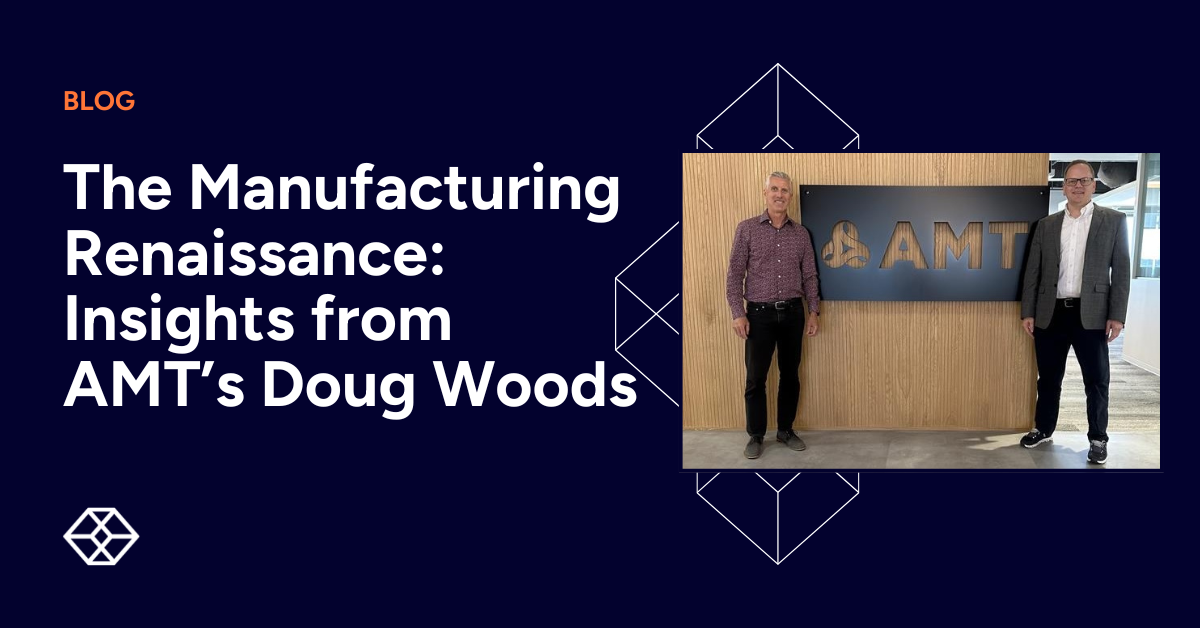
Manufacturing Renaissance: Insights from AMT’s Doug Woods
Manufacturing in the U.S. is in the midst of what Doug Woods, President of The Association for Manufacturing Technology (AMT), calls a “renaissance.”
From the adoption of advanced digital tools to the rise of reshoring, the sector is experiencing historic transformation. But opportunity doesn’t automatically translate to results. Manufacturers face critical decisions about where and how to invest, and how to build resilience for the future.
MASS Group CEO Chris Pickett sat down with Doug to talk about where manufacturers should focus their energy. Below are some highlights from the conversation, along with our perspective on why they matter.
Technology Convergence: From Costly Complexity to Scalable Opportunity
According to Doug, the biggest opportunity manufacturers face today is effectively adopting new manufacturing technologies. The convergence of digital tools with physical operations (IoT sensors, real-time analytics, AI-driven optimization) is making productivity gains and scalability achievable in ways that weren’t realistic even a decade ago.
New technology costs are coming down and their reliability is going up. What once felt experimental is now proven and available at scale. The challenge, as Doug points out, is less about access and more about execution. Companies need a clear strategy for identifying the right technologies and deploying them in ways that directly tie to business outcomes.
Data: From “Digital Exhaust” to Competitive Advantage
Every factory floor today generates data, but not every organization is turning that data into insight. Doug calls this the problem of “digital exhaust.” It occurs when organizations have massive amounts of disparate data, but too little understanding of what matters or how to use it.
The solution lies in creating structured, connected systems. Manufacturers who standardize their data practices and implement platforms that integrate across machines and workflows are better positioned to accelerate decision-making and act on opportunities in real time.
At MASS Group, we see this every day with our clients. When data is unified and contextualized, bottlenecks become visible, predictive maintenance becomes feasible, and compliance tracking moves from reactive to proactive.
AI and Automation: Start with the Problem, Not the Tool
For manufacturers weighing AI and automation, Doug’s advice is straightforward: Don’t start with the technology, start with the business problem.
Identify the single most pressing issue affecting performance or profitability, then look for tools that directly address that issue. This ensures ROI is measurable and prevents wasted investments in “solutions in search of a problem.”
It’s a principle that aligns perfectly with MASS Group’s philosophy of product-led modularity: Scale into advanced features as your needs evolve, rather than overcommitting upfront.
The Workforce: Usability Is Non-Negotiable
Even as advanced technologies reshape manufacturing, the workforce challenge remains urgent. As Doug explains, technology platforms must prioritize usability. That means intuitive interfaces, modular workflows, and templates that allow even less-experienced workers to ramp quickly.
Usability goes far beyond convenience; it’s about competitiveness. Manufacturers that invest in user-friendly systems enable their teams to adopt new tools with less resistance, reduce training overhead, and keep production moving despite talent shortages.
Reshoring: Agility at Scale
Reshoring is gaining momentum, but sustaining local production at scale requires more than just domestic facilities. It demands flexibility with systems and equipment that can pivot rapidly to meet changing customer needs, adapt production volumes, and offset workforce shortages with automation.
Those who succeed will be the manufacturers who treat flexibility as a core operational capability, not just a contingency plan.
Trustworthy AI: Governance from Day One
AI’s potential is enormous, but so are the pitfalls. From data quality to model “hallucinations,” the risks are real. Doug stresses that manufacturers must establish clear data governance policies and assign executive-level ownership to AI oversight.
Trust doesn’t emerge organically; it must be built deliberately into operations. When AI is deployed within a framework of governance and accountability, manufacturers can accelerate innovation without sacrificing confidence.
For more on manufacturing AI ethics and governance, see NIST's AI Risk Management Framework or IEEE's Ethically Aligned Design.
Final Thoughts
The “manufacturing renaissance” isn’t just a headline, it’s reality. But seizing the opportunity requires discipline—focusing on real problems, structuring data, prioritizing usability, and embedding trust from the start.
As Doug Woods makes clear, technology is only part of the equation. The real differentiator is how manufacturers integrate those technologies into resilient, agile, human-centered systems.
At MASS Group, we believe this is where the future of manufacturing is headed, and we’re proud to help our customers get there. Learn more, schedule a demo.


